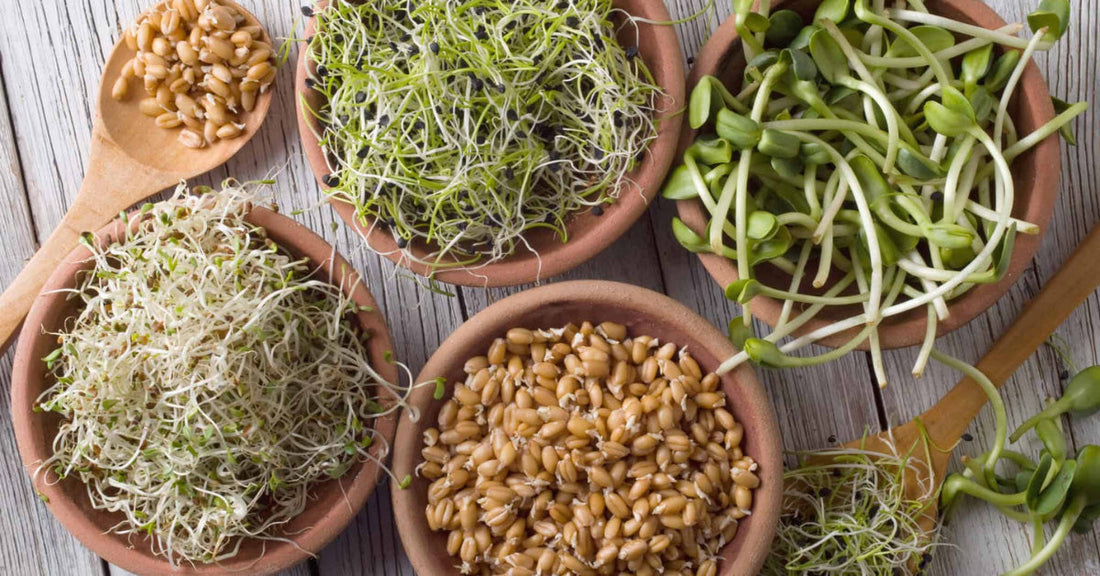In recent years, new types of sprouts and micro-shoots have stolen the spotlight from alfalfa. It's now possible to enjoy a range of different sprouts in sandwiches, salads and garnishes. Many people try sprouts and microgreens for their beneficial properties, but few actually make them at home.
Here's how (and why) to make your own sprouts and microgreens at home.
Benefits of sprouts
Because of their nutritional density, sprouts and microgreens have many benefits. In fact, they are more nutritious than most mature plants. Depending on the type of sprouting and/or germination, their nutritional potential is 9 to 40 times higher than that of mature plants.1, 2
In particular, sprouts contain more :
- Protein ;
- Enzymes ;
- Minerals, especially calcium, potassium, magnesium, selenium, zinc and iron;
- Vitamins A, C and E;
- Polyphenols ;
Thanks to their nutritional value, sprouts and microgreens help prevent certain diseases, including :
- Cardiovascular disease ;
- Hypercholesterolemia;
- Alzheimer's disease;
- Diabetes ;
- Certain cancers.
Sprouting at home
Germinations are seeds that have germinated, giving rise to small plants in their very first stage of life. Germinations are carried out in ambient air, inside a special jar placed in a dark, damp place to trigger germination. The germination process is fairly rapid, with sprouts generally ready to eat in less than 5 days.
The most common types of sprouts are alfalfa, broccoli, radish, clover, legumes and nuts.
To make sprouts at home, all you need is a clear container, a cloth that allows the water to drain (clean nylon stockings, cotton cloth, lined cheesecloth) and quality seeds. Then follow the steps below in order.
- Soak a small quantity of seeds (about 1 tablespoon) in a glass jar and submerge the seeds in water. Cover the jar opening with a cloth and leave the seeds to soak for 8 hours.
- Drain and rinse seeds.
- Place a cloth over the jar opening and secure with a rubber band. Position the jar so that the opening faces downwards, allowing water to drain out at an angle of around 45°.o. Rinsing water must be able to run off constantly to prevent mold growth.
- Repeat twice a day, at 12-hour intervals, for 2 to 5 days, or until sprouts are 2cm long.
- Rinse well and pat dry before refrigerating. Consume within a few days.
Many people opt for sprouting in a germinator to facilitate handling and allow adequate water drainage.
Method without manual drainage
- Spread 1 tablespoon of seeds on the tray.
- Add water as indicated. The siphon action automatically distributes water every day and ensures irrigation.
- In 2 to 4 days, the sprouts will be ready to eat.
Method with Passion Santé sprouting kit
- Submerge seeds in water for the required time.
- Drain the soaking water using the perforated base as a strainer. Rinse well, cover with perforated lid.
- Twice a day, at 12-hour intervals, rinse and drain seeds using the perforated base.
- Once the germination period is over, your sprouts are ready to eat.
*The complete Passion Santé sprouter set includes everything you need for sprouting and making your own tofu.
Home-made micro sprouts on soil
Micro sprouts on potting soil are actually small vegetables. These tiny growths are somewhere between sprouts and microgreens. Not to be confused with germinations, micro-sprouts are baby plants that are harvested within 21 days of sowing, or when the first leaves have appeared.
Shoots of broccoli, radishes, fennelmustard, beet, kohlrabispinach, wheat and buckwheat are among the most widely grown microfoams.
To grow microfoots at home, all you need is some quality potting soil (preferably organic) or an absorbent cloth, a container (tray or plastic tub), seeds and a spray bottle of water, then carry out the following steps.
- Fill the container/ tray with moist organic potting soil, avoiding compacting the organic matter.
- Scatter the seeds over the surface of the potting soil so that they are close together. If you're growing wheat, sunflower, buckwheat (or any other large seed), cover the seeds with potting soil and moisten the surface with a water spray. If you're growing small seeds (broccoli, radish, beet, etc.), simply moisten the surface without covering with potting soil.
- Place the tray in a bright spot and spray generously with potting soil every day.
- Depending on the type of micro-shoot grown, shoots will be ready between 7 and 21 days, or when the first true leaves appear (not to be confused with cotyledons, the first round leaves).
- To harvest, cut the micro-shoots just above the potting soil using clean kitchen knives. Rinse, drain and store in the fridge for 2 to 3 days.
Avoid common problems
Prevent mold: Add 1 tsp. citric acid per liter of soaking, rinsing and sprinkling water. Food-grade citric acid is 100% safe to use. It's an acid naturally present in lemons that acts as an anti-mould agent.
Preventing food-borne illness (poisoning): sprouts sometimes have the bad reputation of being vectors of diseases associated with Salmonella and e.coli. To prevent food-borne illness, buy only sprouting seeds that have been tested, and be sure to disinfect any surfaces that come into contact with the seeds with hydrogen peroxide and be sure to wash your hands thoroughly after handling.
We wish you good health!
The team at La Boite à Grains
Sources :
- Edgar Pinto et al. Comparison between the mineral profile and nitrate content of microgreens and mature lettuces. Journal of Food Composition and Analysis. Volume 37, February 2015, Pages 38-43
- Xiao Z, Lester GE, Luo Y, Wang Q. Assessment of vitamin and carotenoid concentrations of emerging food products: edible microgreens. Journal of Agricultural and Food Chemistry. 2012;60(31):7644-7651.
- Singh AK, Rehal J, Kaur A, Jyot G. Enhancement of attributes of cereals by germination and fermentation: a review. Crit Rev Food Sci Nutr. 2015;55(11):1575-1589.
- Chon SU. Total polyphenols and bioactivity of seeds and sprouts in several legumes. Current Pharmacology Design. 2013;19(34):6112-6124.


